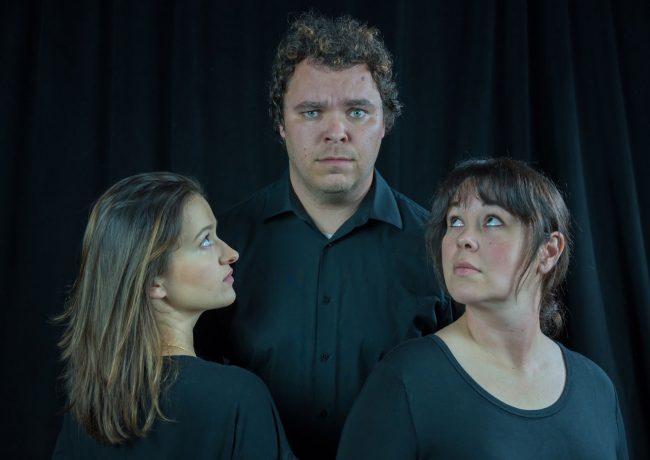
When City Repertory Theater stages “The Crucible,” Arthur Miller’s play about witch-hunting in 17th-century Salem and –- allegorically — Joseph McCarthy’s Communist sniffing in mid-20th-century America, the ghost of the playwright will know his 1953 Tony Award-winning work will be in capable hands.
Director Les Ober, who retired to Palm Coast with his wife in 2019 after 52 years of directing professional regional and high school theater in northern Connecticut, once got a nod of approval from Miller himself.
During Ober’s 37-year tenure as a teacher and head of the theater department at Northwestern Regional High School in Winsted, Conn., he was directing his young cast in Miller’s 1950 adaptation of “Enemy of the People,” that 1882 drama by Norwegian playwright Henrik Ibsen.
“Every other year we did a pretty heavy play,” Ober says during rehearsal at the covered, outdoor pavilion at the Palm Coast Arts Foundation, where “The Crucible” will be staged April 9-18. “Usually Shakespeare, or Ibsen, O’Neill, something really heavy, a lot of Tennessee Williams.”
After a performance of “Enemy of the People,” Ober says, “A couple of the staff people I worked with came over to me and said, ‘Les, how did you get Arthur Miller to come see your play?’ I said, ‘Come on guys, don’t do this.’ ”
But Ober and others knew that Miller, who had his critics but is widely considered one of the titans of 20th-century American drama, lived in nearby Roxbury.
“Some of my family were there,” says Ober, who earned BA and MA degrees in communications and theater from the University of Hartford. “I said, ‘Do you know who Arthur Miller is?’ They said, ‘Yeah, he was at your play.’ I said, ‘You know what he looks like?’ They said, ‘Sure, he was on a TV talk show a little while ago.’ My niece said, ‘He sat about five seats away from me. At the end of the show, he kind of nodded his head and left.’
“Thank God I didn’t know he was in the audience watching the play,” Ober adds with a hearty laugh.
These days, although his wife told him they were moving to Florida to retire, Ober is back directing the heavy stuff, having his third go at “The Crucible” in his half-century career, which also included a 15-year stint with the professional regional troupe at the Warner Theatre in Torrington, Conn.
It wasn’t only critics and English teachers who insisted Miller’s most popular play (followed closely by “Death of a Salesman”) took the Salem witch trials of the 1690s and made them something of an allegory for the Communist hysteria and “witch hunts” stirred up in the 1940s and ’50s by U.S. Sen. Joseph McCarthy as well as the House Committee on Un-American Activities. (Though McCarthy and HUAC are often conflated, the senator had no direct involvement with the committee, and it was the latter whose inquires caused the most trouble for Hollywood, leading to blacklists in which more than 300 directors, actors and screenwriters were boycotted by the studios for alleged Communist activities.)
In a revelatory, 1996 first-person New Yorker piece titled “Why I Wrote ‘The Crucible,’ ” Miller said “the hunt for Reds in America” . . . “formed ‘The Crucible’ ’s skeleton.” However, Miller added, “I had not approached the witchcraft out of nowhere, or from purely social and political considerations.” He had read about the Salem witchcraft trials in college, and was spellbound by Charles W. Upham’s 1,000-page, 1867 account of the era before visiting Salem himself in 1952.
Numerous scholarly and popular texts have been written about the Salem witch trials, and observers have proffered all sorts of theories behind the mass hysteria. Those theories begin, of course, with the historically documented evidence that the Puritans of colonial Massachusetts, including minister Samuel Parris, indeed feared, to various degrees, that the devil and his minions the witches preyed upon innocent humans. That fear was magnified when several young girls in the colony, including Parris’s daughter Betty and his niece Abigail Williams, began to exhibit overt, strange behaviors after fraternizing with the slave Tituba, who was owned by Parris. Scholars have postulated various possible factors behind the girls’ fits, bodily contortions, weird vocalizations and complaints of feeling bitten: mental illness, ergot poisoning, encephalitis, “juvenile delinquency,” etc.
Regardless, the girls’ odd behavior amped up the Puritans’ fear that the devil was running amok. Pressured by Parris, the girls said they had been bewitched by Tituba and two other women of the community. Tituba was likewise pressured until she “confessed,” in vivid terms, that she had been visited by the devil and his animal “familiars,” and that she had witnessed the names of several villagers inscribed in the “devil’s book.”
The hysteria escalated and soon charges of witchcraft were levied by neighbors against neighbors. More than 200 people were accused and prosecuted at hearings between February 1692 and May 1693. Thirty were found guilty, and 14 women and five men were executed by hanging, while one man who refused to plead guilty or innocent was pressed to death, and at least five people died in jail.
Miller’s play makes use of that history and historical figures such as John Proctor, Parris, Tituba, the young Abigail Williams, and others.

“Broadway audiences were not famous for loving history lessons, which is what they made of the play,” Miller rued in his New Yorker essay, referring to the witch hunts of both Salem and McCarthyism, and to the sputtering start of “The Crucible,” which initially received mixed reviews and garnered a tepid box-office take. Eric Bentley, drama critic for The New Republic, was unimpressed by the play and sniffed that “the world has made this author important before he has made himself great.”
Though the initial production won the 1953 Tony Award for Best Play, it wasn’t until a second production a year later that “The Crucible” was crowned a success and began its journey to achieving canonical status.
Ober, who became friends with City Rep director and co-founder John Sbordone after attending a CRT workshop performance, is adamant that theatergoers need not be privy to the history of the Salem witch trails or of America’s “Red Menace” era.
“It’s almost a necessity that we set the play in Puritan times,” Ober says. Yet he notes that Miller took liberties with history: “Abigail, who is really the villain of the play, was only 13 years old. It was Miller who decided to make her 17, 18 years old . . . Then of course he had to have a little sex to sell it on Broadway, so he has this affair between John Proctor and Abigail going on. That is not in the books, that is not historical – that is poetic license Miller took.”
Ober subscribes to the mental illness theory to explain the aberrant behavior of the girls, especially Abigail, who is played by Agata Sokolska.
“Was there mental illness in Salem?” he says. “It ran rampant. Abigail is a screwed-up young girl. In the scene with Abigail and John Proctor (played by CRT veteran Beau Wade), she goes through all these transformations in her character – she’s almost bipolar, schizophrenic. That’s the way we approached it. We are doing a very modern, contemporary approach on how to look at this play. Will the audience understand that she’s going through all those character changes? Maybe not. But she can go from angry to a little girl to being very seductive literally with the snap of a line. And that’s what we try to portray.”
“Abigail has a dark past,” Sokolska says. “She experienced traumatic events in her life when she was younger. That’s kind of the motivation of why she does certain things. She doesn’t have control over her emotions or how she is expressing herself.”
Joshua Childers, who plays Parris, adds: “Simplistically too, she’s a kid who gets caught with her hand in the cookie jar, and will do anything to get out of it.”
Phillipa Rose, who plays Tituba, says the slave from Barbados confessed to witchcraft and pointed her finger at others “to save her own life. Unfortunately, it was a selfish thing to do, but when you think back on that timeframe, she made the choice that was best for herself.”
Indeed, history records that Tituba avoided execution and was instead jailed and later freed back into servitude.
“I am not sure what ‘The Crucible’ is telling people now,” Miller wrote in 1996. “But I know that its paranoid center is still pumping out the same darkly attractive warning that it did in the ’50s.”
For Childers, who has prepared for his role by studying the historical accounts and even reading some of the actual sermons of Parris, it’s a no-brainer that the great plays of the ages continue to resonate with theater-goers: “The more I do plays and the more I hear the sentiment ‘Oh this is so relevant to today,’ the more I deduce it’s just the human condition.”
He notes contemporary America is not immune to paranoia and large-scale hysteria: “QAnon comes to mind. These people of Salem were so oppressed, and speaking out against the church was blasphemous. It became a free-for-all, almost like social media these days.”
Beau Wade, who portrays John Proctor, one of the accused, says, “We still have those same problems where massive lying and group-think and corruption still inform a lot of what we have to go through. And there are crazy things in America today like the Patriot Act – if at any point they wanted to come pick you up and say you’re a terrorist, they could put you away and not give you a trial for years. So, we still do kind of live in a world where Salem witch trials still happen to people.”
–Rick de Yampert for FlaglerLive
![]()
City Repertory Theater will stage “The Crucible” at 7:30 p.m. April 9-10 and 16-17, and 3 p.m. April 11 and 18. Performances will be at the Palm Coast Arts Foundation pavilion, in Town Center, 1500 Central Ave., Palm Coast. Tickets are $20 general admission, $15 students with ID. Tickets are available at crtpalmcoast.com, by calling the CRT box office at 386-585-9415, or at the door the day of the show. Patrons are expected to wear masks.






























Steve says
My Hope is that there is standing room only. Sounds like a Qualified Professional Group. Go have a look see
Bob says
30 years ago I would have agreed that the Mccarthy hearings were a witch hunt. But today I’m not so sure. Our colleges have become Socialist indoctrination centers, Hollywood is a cesspool of moral subversion where pedophilia is an open secret, and the halls of Congress are filled with spineless criminals who vote to support people sneaking into the county illegally with YOUR hard-earned money. And then there’s the 1990’s interview of the ex high-up in the old Soviet KGB who talks about their long term plan to undermine our society and move us toward first socialism then communism, using the groups I mentioned above (Hollywood, professors, low and higher level politicians) and others. Then around that same time there was the seemingly reasonable beginnings of ‘political correctness’ which is factually what Mao used to isolate and destroy opposition and resisters in China. Hmm…
Did many of those accused by Mccarthy make up lies about others to save their own skins? Of course they did. Were ‘lists’ being made? We know they were. Were many of the accused actual communists? We know they were by their own words and writings. So that’s a lot to think about. Makes me wonder when I look around today …
Mod says
I saw this play last night
It was emotionally charged, the actor were incredible
The rain made it magical under a tent hearing the frogs brought the past and the future together as one.
If reminds me of the saying:the more things change the move they stay the same.
1692 /2012. A lie is a lie and will always be pushed by those who have nothing more inside that to gain and take something from another.
The sad part plays out when lives are changed for the worst.
I cried watching this play knowing that: while the actor brought it to life
Go see it and be amazed, come out knowing when it touches your soul.
As it touch mine: life for all that it is… is just……..diamond in the rough
John Proctor.
Thanks for sharing and making us all remember on a rainy Friday night.